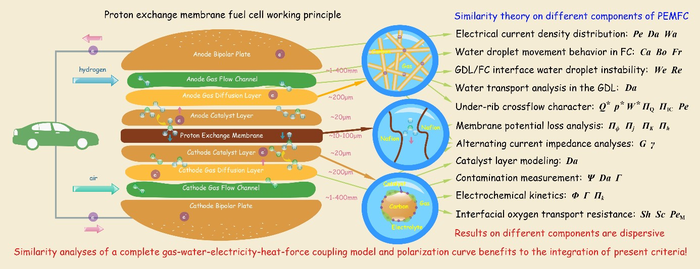Globally, research groups focusing on technology associated with hydrogen production are constantly increasing, which is now extensively believed to be the ultimate clean energy carrier.
 Hydrogen is regarded as the ultimate clean energy carrier, but an efficient fuel cell is needed to produce electricity from it. Proton exchange membrane fuel cells, our current best bet, are complex to design and study because of the sheer number of design parameters involved, and similarity theory could be the tool we need to solve this challenge. (Image Credit: Professor Wen-Quan Tao from Xi’an Jiaotong University, China).
Hydrogen is regarded as the ultimate clean energy carrier, but an efficient fuel cell is needed to produce electricity from it. Proton exchange membrane fuel cells, our current best bet, are complex to design and study because of the sheer number of design parameters involved, and similarity theory could be the tool we need to solve this challenge. (Image Credit: Professor Wen-Quan Tao from Xi’an Jiaotong University, China).
However, the transformation of hydrogen into an operational form of energy, such as electricity, is just as crucial. Incidentally, proton exchange membrane fuel cells (PEMFCs) are currently the ideal option.
The operating principle of PEMFCs is quite easy to grasp; a hydrogen oxidation reaction occurs at the anode, an oxygen reduction reaction takes place at the cathode, and the only products are electricity and water.
However, in real-world PEMFC implementations, numerous associated processes and technical aspects, such as material selection, mechanics, thermofluidics and electrochemistry, to name a few, must be taken into consideration. Thus, PEMFC research has increased rapidly in the last 10 years as researchers try to resolve all the challenges that crop up along the path towards efficient and scalable PEMFC technology.
Regrettably, the complexity and multi-layered nature of PEMFC systems together with the flood of published articles have made it hard to correctly gauge the progress that is actually happening.
That is to say, the multiplicity of parameters involved in engineering PEMFCs not only renders them a hard and laborious topic to study but also makes quantitative comparisons between various implementations a lot harder.
But what if a framework existed wherein one could at all times compare apples to apples, i.e., one could compare studies using various parameters reliably, regardless of their methodological diversity?
In a new review article published in Energy Storage and Saving, scientists from Xi’an Jiaotong University, China, encapsulate the latest efforts for adopting such a framework in the research of PEMFC: similarity theory.
Also called dimensionless analysis, similarity theory is founded on describing a system using dimensionless parameters, which perfectly capture the relationships between a much higher number of input (dimensional) parameters.
Researchers, using the similarity theory, can report on the outcomes of PEMFC designs in such a way that other groups can flawlessly compare them with their own results.
Furthermore, rather than having to conduct experiments where numerous input parameters are varied one by one to evaluate their effect, the similarity theory strives to identify significant dimensionless relationships between these parameters and the output values, thereby saving a lot during the experimentation stage.
The article describes a detailed review of how dimensionless analysis has been used in the PEMFC study. It has been split into four important parts: the characteristics of membrane electrode assemblies, measurements of PEMFC contamination, flow channel or gas diffusion layer transport processes and electrochemical kinetics.
The objective of our review was to highlight and analyze the benefits of similarity theory, including the derivation of a general law, reduction in testing efforts, ease of comparison between different studies, and the provision of guidance for scaling up experiments. We want to motivate scientists to formulate dimensionless expressions of their PEMFC research to obtain more general and concise conclusions.
Wen-Quan Tao, Professor and Scientist, Jiaotong University
Although the similarity theory has certainly entered into PEMFC research, there is still quite a lot of work to be carried out to unravel its true potential. As mentioned in the review, the total number of dimensionless criteria that have been derived so far is really high, and they are inclined to focus on various parts of PEMFC systems.
Thus, scientists could really gain from more unified and dimensionless performance criteria resulting from the differential equations for the total processes in PEMFC rather than concentrating only on single parts.
In the article, the researchers propose a way in which this issue could be handled through a subsequent hierarchical grouping of criteria based on the direct impact of a criterion on either the individual subprocesses or integrated performance.
Overall, it seems similarity theory could be a dominant approach to hasten progress in PEMFC research. However, as Professor Tao comments, much work still has to be completed.
Although similarity theory is an effective tool to derive general laws, our review indicates that none of the existing models for PEMFCs can achieve this objective, and further research pertaining to this aspect must be performed.
Wen-Quan Tao, Professor and Scientist, Jiaotong University
It is anticipated that the similarity theory gains the attention it merits so that high-performance PEMFCs enter into clean energy technologies of the future.
Journal Reference:
Bai, F., et al. (2021) Application of similarity theory in the study of proton exchange membrane fuel cells: A comprehensive review of recent developments and future research requirements. Energy Storage and Saving. doi.org/10.1016/j.enss.2021.09.001.